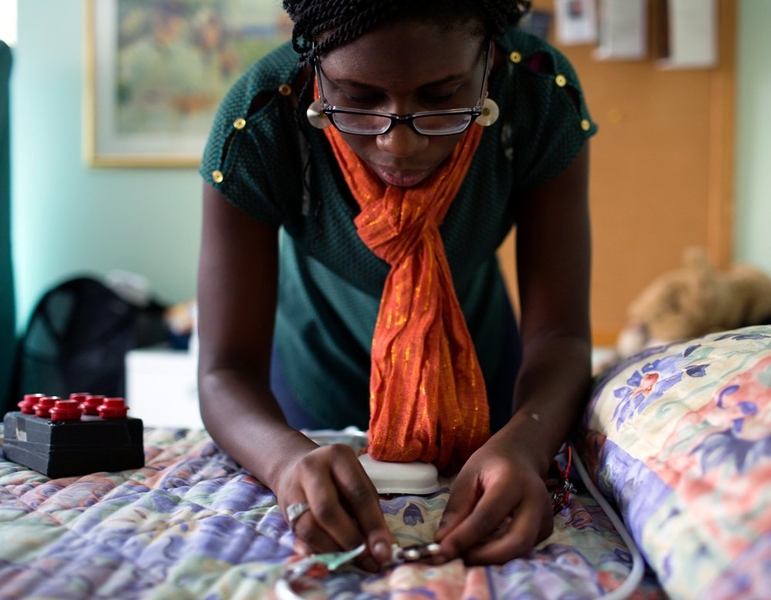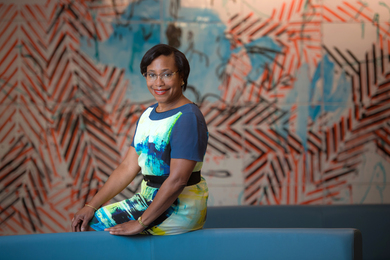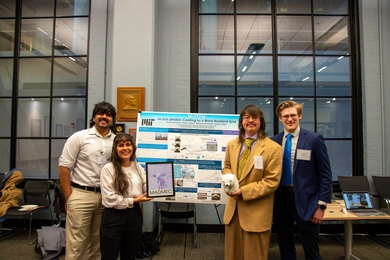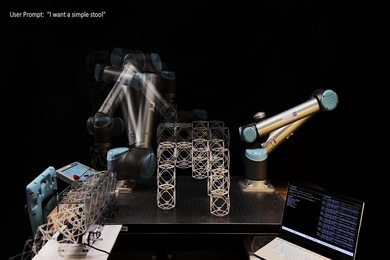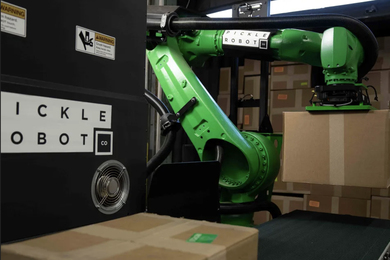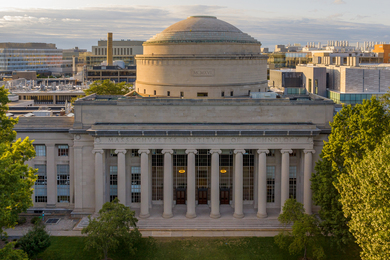This is part of an occasional series of features profiling academic departments at MIT.
In the 1950s, when MIT researchers were helping to invent the discipline of computer science, they didn't think of themselves as computer scientists; they thought of themselves as electrical engineers or physicists or mathematicians. Operating systems and programming languages were just tools they needed in order to maximize the productivity of the hugely complex new machines they were building.
By 1975, however, computer science had developed enough autonomy that MIT's Department of Electrical Engineering changed its name, becoming the Department of Electrical Engineering and Computer Science (EECS). Now, the Computer Science and Artificial Intelligence Laboratory (CSAIL) is the largest lab at MIT.
EECS may now be in the midst of a similar expansion of its intellectual boundaries. According to department head Anantha Chandrakasan, the Joseph F. and Nancy P. Keithley Professor of Electrical Engineering, some of its most exciting research lies at the intersections of EECS and other disciplines. That includes research on "big data" — techniques for making sense of the massive amount of information unleashed by the Web, by biological, medical and physics research, and by the financial industry — as well as energy and biomedical research. "More than a third of our faculty are interested in the biomedical space," Chandrakasan says.
At the same time, Chandrakasan says, the core EECS curriculum is more popular than ever. EECS has long drawn the largest undergraduate enrollment at MIT, since the days when it was just EE. But this year, Chandrakasan says, enrollment in the department's two introductory courses — 6.01 and 6.02, in MIT's course-numbering system — reached an all-time high. "Nearly half of MIT undergraduates take 6.01, regardless of major," Chandrakasan says.
Data deluge
With big data, the field is, in large part, reaping what it sowed. Exponential increases in computing power, and simpler tools for exploiting it, have led to an explosion of online data. But as rapidly as computers have improved, gene-sequencing machines have improved even more rapidly. Meanwhile, physics experiments at the Large Hadron Collider can generate petabytes of data every day.
Andrew Lo, the Charles E. and Susan T. Harris Professor of Finance at the MIT Sloan School of Management, who has been on the MIT faculty since 1988, last year accepted a secondary appointment in EECS and became a primary investigator in CSAIL. Recently, Lo has used techniques borrowed from computer science to mine credit-bureau data and data about the transactions conducted by customers of financial institutions to more accurately predict the risk of default or delinquency.
Lo is one of the researchers at bigdata@CSAIL, a new initiative led by professor of computer science and engineering Sam Madden. Madden investigates techniques for searching databases more efficiently and for interpreting sensor data from networks of cars, among other things. Other project participants include professor of computer science and engineering Piotr Indyk, whose new algorithm for calculating the discrete Fourier transform — developed with professor of computer science and engineering Dina Katabi — has a broad range of applications in the big-data context, and associate professor of computer science and engineering Rob Miller, who finds ways to enlist human aid in the execution of large information-processing tasks.
As people store more of their data online, however, it becomes more vulnerable to attack. Nickolai Zeldovich, an associate professor of software technology and another member of bigdata@CSAIL, has, together with Frans Kaashoek, the Charles A. Piper Professor of Computer Science and Engineering, researched ways to plug security holes in web applications; Zeldovich and Katabi introduced a new way to prevent the interception of wireless transmissions. And cryptography luminary Shafi Goldwasser, the RSA Professor of Computer Science and Engineering and a two-time winner of the Association for Computing Machinery's Gödel Prize for theoretical computer science, has developed algorithms that protect data stored in the cloud from particularly ingenious attacks.
Goldwasser's colleagues in the Cryptography and Information Security Group at CSAIL are no less illustrious. Silvio Micali, the Ford Professor of Engineering, shared the first-ever Gödel Prize with Goldwasser for the development of zero-knowledge proofs. The group's other faculty members, adjunct professor of computer science and engineering Butler Lampson and Ron Rivest, the Andrew and Erna Viterbi Professor of Computer Science and Engineering, are recipients of the Turing Award, commonly referred to as the Nobel Prize of computer science. (In all, nine researchers affiliated with MIT have won the Turing Award, most recently Institute Professor Barbara Liskov, in 2009.)
Biology and energy
Other CSAIL researchers, such as associate professor of computer science Manolis Kellis and professor of computer science and engineering David Gifford, are developing novel algorithms for finding biologically informative patterns in mountains of genetic data. But another central area of convergence between computer science and medicine is the analysis and interpretation of signals from biomedical sensors.
For instance, CSAIL's Polina Golland, an associate professor of computer science and engineering, finds correlations between anomalies in brain scans and neurological disorders. Similarly, George Verghese of the Research Laboratory of Electronics (RLE), the Henry Warren Ellis Professor of Electrical Engineering, has developed algorithms that could infer changes in intracranial pressure from noninvasive-sensor data such as ultrasound scans and blood pressure measurements, rather than requiring physicians to drill holes in their patients' skulls. CSAIL's John Guttag, the Dugald C. Jackson Professor of Computer Science and Engineering, and RLE's Collin Stultz, an associate professor of biomedical engineering, have mined electrocardiogram data to more accurately diagnose patients at risk for heart failure; RLE's Elfar Adalsteinsson, an associate professor of electrical engineering and computer science and health sciences and technology, and Vivek Goyal, an associate professor of electrical engineering and computer science, developed algorithms that could reduce the duration of MRI scans from 45 to 15 minutes.
The search for alternative sources of energy is squarely within the purview of classical electrical engineering: RLE researchers such as associate professor of electrical engineering Mark Baldo and professor of electrical engineering Vladimir Bulovic, for instance, are developing flexible, transparent and even printable solar cells, while Bulovic and Jing Kong, the ITT Career Development Associate Professor of Electrical Engineering, showed that graphene — an atom-thick layer of carbon atoms — could offer a much more cost-effective way to provide electrodes for such devices. Tomás Palacios of the Microsystems Technology Laboratory, the Emanuel E. Landsman Career Development Associate Professor of Electronics, has shown that using gallium arsenide in power converters that switch between alternating and direct current could cut mechanical devices' power consumption by 30 percent.
Associate department head Munther Dahleh, professor of electrical engineering and computer science, on the other hand, is approaching the energy problem less directly. Among other things, Dahleh investigates how the type of control principles studied at the Laboratory for Information and Decision Systems can be brought to bear on management of the power grid.
Undergrads as innovators
The department's undergraduate curriculum, too, has an increasingly interdisciplinary flavor. Its introductory courses, 6.01 and 6.02, concentrate on robotics and communications, respectively, canvassing a wide range of topics — from control theory and algorithms to signal processing and circuit design. Chandrakasan says the department is planning to offer a third introductory course, which will concentrate on biomedical applications of EECS principles.
The creation of a third introductory course is an element of Chandrakasan's strategic plan for the department, which EECS leaders began developing soon after he became department head in 2011. The plan's hallmark educational initiative, however, is the so-called "SuperUROP" program, which builds on MIT's much-emulated Undergraduate Research Opportunities Program (UROP). Founded in 1969, UROP offers funding and academic credit to undergraduates who do original research in MIT labs.
While the majority of UROP projects last only a semester, SuperUROP projects last a full year, and students are required to take a yearlong course in which a series of outside speakers discuss both research topics and entrepreneurship. Each student receives a stipend for the year, and each faculty supervisor gets additional funding in his or her lab budget. The yearlong student commitment, and the additional research funding, makes sponsoring a SuperUROP student much more attractive to faculty, Chandrakasan says; this greater faculty involvement, in turn, enriches the undergraduates' experience.
The SuperUROP program launched this fall — with funding from both private donors and a roster of 14 corporate sponsors — and 86 EECS undergraduates enrolled. At the beginning of the year, the program's website posted a detailed list of more than 100 research projects that faculty were willing to supervise; the corporate sponsors posted a second list. But several students opted instead to create their own projects and find faculty to sponsor them. Indeed, Chandrakasan says, one of the program's aims is to provide an outlet for the entrepreneurship that seems to be second nature for many MIT students.
Meet the real world
The SuperUROP initiative illustrates another principle that, Chandrakasan argues, has been crucial to the success of EECS at MIT: corporate partnership. Both CSAIL and MTL have existing programs for corporate sponsors — respectively, the Industry Affiliates Program and the Microsystems Industrial Group. Both programs provide companies with opportunities to sponsor research, to initiate joint projects, and to keep abreast of the labs' research. In turn, the programs help match MIT students with prospective employers.
Recently, Chandrakasan points out, some CSAIL professors have begun to engage with industry in novel ways. Three years ago, professors of computer science and engineering Charles Leiserson and Saman Amarasinghe, who co-teach 6.172 (Performance Engineering of Software Systems), initiated a program that recruits senior programmers from the Boston area to review the code written by students in the class. In the program's first few years, Leiserson has said, he and Amarasinghe had to turn volunteers away.
Similarly, Miller has recruited MIT alumni to help with code reviews in a course he teaches, 6.005 (Elements of Software Construction). There, however, the mechanism is much different. Where the volunteers in Leiserson and Amarasinghe's course meet with students in pairs, those in Miller's course examine small chunks of code online whenever they have time.
Indeed, cultivating an "alumni teaching network" is another aspect of EECS's strategic plan, Chandrakasan says. "We want to engage the broad network of our alumni, but also experts out there in industry," he says.
The department is also in the process of building a new Engineering Design Studio, led by professor of mechanical and electrical engineering and computer science Steven Leeb. Chandrakasan describes it as "a hands-on advanced-prototyping lab where students can prototype both mechanical and electronic systems, including biomedical devices. We'll have state-of-the-art wireless components and devices from electronic-systems manufacturers. We'll have tutorials from industry people through videoconferencing, teaching students how to build and use systems." The studio would be available for lab assignments in undergraduate courses and to undergraduates pursuing independent projects, Chandrakasan says.
Equalizing opportunities
Even as EECS takes steps to enhance the educational experience for MIT students, it's also assumed a leading role in edX, an ambitious project to make the educational resources of MIT, Harvard University, the University of California at Berkeley, and the University of Texas system — and, over time, other universities — available to students worldwide. The first course offered through edX was an EECS class, 6.002x (Circuits and Electronics), and professor of computer science and engineering Anant Agarwal, the CSAIL head who stepped down to become president of edX, led a group of EECS researchers in developing the technological platform that undergirds the whole system. Since the introduction of 6.002x, Chandrakasan says, on-campus enrollment in 6.002 has gone up by 40 percent.
In addition to its educational initiatives, the department's strategic plan also aims to increase the number of women faculty in electrical engineering and computer science. The centerpiece of that project is "Rising Stars in EECS," an annual workshop, created by Chandrakasan and Golland, that brings talented women from the nation's top EECS graduate programs to the MIT campus for two days of symposia and talks on research and job-search skills. The first such workshop was held earlier this month.
